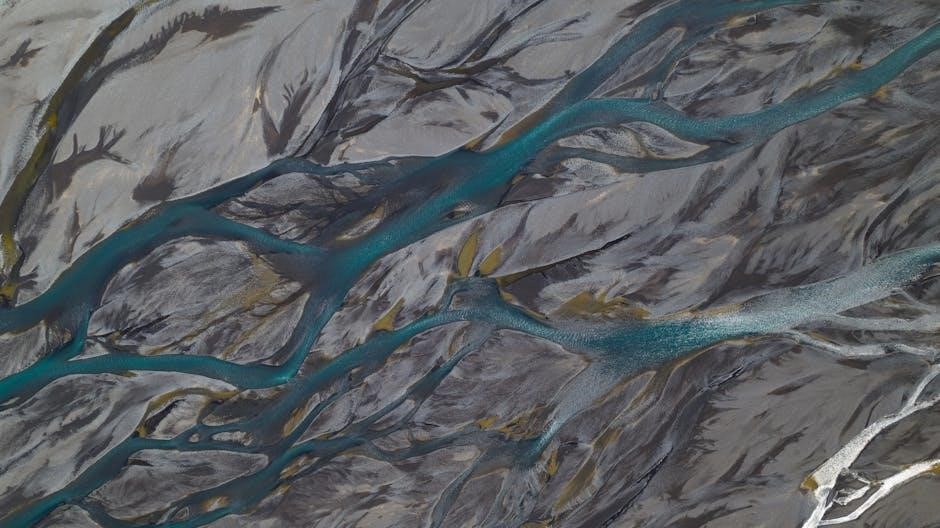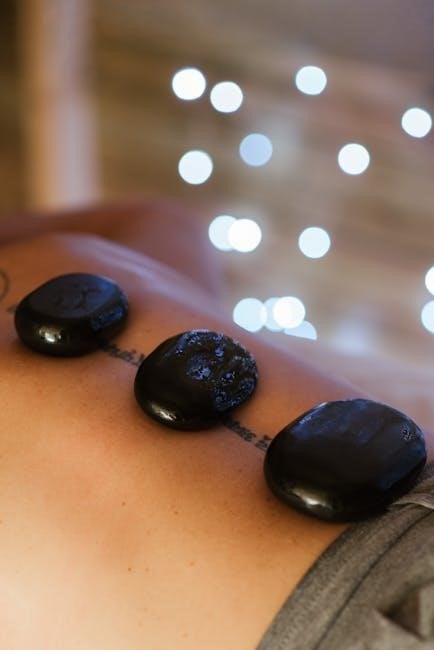Manual Lymphatic Drainage (MLD) is a gentle, specialized massage technique that promotes the movement of lymph fluid through the lymphatic system. It is commonly used to alleviate lymphedema, reduce swelling, and support overall lymphatic health. While MLD is beneficial for many, certain conditions make it unsuitable, highlighting the importance of understanding its contraindications.

General Contraindications for Manual Lymphatic Drainage
MLD is contraindicated in conditions where increased lymph flow could worsen health, such as infections, fever, or severe circulatory issues, emphasizing the need for careful assessment before treatment.
Absolute Contraindications
Absolute contraindications for Manual Lymphatic Drainage (MLD) are conditions where the treatment could lead to serious health complications. These include active infections, severe acute inflammation, or systemic infections like cellulitis, as MLD could spread the infection. Deep vein thrombosis (DVT) is another absolute contraindication, as the treatment might dislodge a blood clot, leading to a pulmonary embolism. Active cancer or the presence of cancerous tissues is also contraindicated, as MLD could inadvertently spread cancer cells. Additionally, severe kidney failure, where the body cannot process lymphatic fluid effectively, and congestive heart failure, where increased lymph flow could overload the heart, are absolute contraindications. Radiation dermatitis or severely damaged skin should also avoid MLD, as the treatment might exacerbate tissue damage. Venous thrombosis and acute fever are similarly contraindicated, as they indicate the body is in a fragile state. In these cases, MLD could worsen the condition, making it essential to avoid treatment entirely. Professional consultation is crucial to ensure safety and avoid potential risks.
Relative Contraindications
Relative contraindications for Manual Lymphatic Drainage (MLD) involve conditions where the treatment may need to be adjusted or approached with caution, rather than being entirely avoided. These include chronic infections, where MLD might be used cautiously under medical supervision. Conditions like moderate kidney dysfunction or stable heart conditions may require modified techniques to prevent overloading the system. MLD should also be used with care in cases of pregnancy, as certain techniques might stimulate the uterus. Patients with implanted medical devices, such as pacemakers, should consult their healthcare provider to ensure safety. Additionally, MLD may be adapted for children, requiring specialized techniques suited to their smaller anatomy. Relative contraindications emphasize the need for personalized assessment and professional guidance to ensure safe and effective treatment. They highlight the importance of tailoring MLD to individual health circumstances, balancing potential benefits against possible risks.

Specific Contraindications for Manual Lymphatic Drainage
Specific contraindications include infections, fever, deep vein thrombosis, kidney failure, congestive heart failure, active cancer, radiation dermatitis, cellulitis, and venous thrombosis. These conditions require careful consideration to avoid complications.
Infections or Fever
Active infections or the presence of a fever are absolute contraindications for Manual Lymphatic Drainage (MLD). When the body is fighting an infection, the lymphatic system is already under stress, working to neutralize pathogens and reduce inflammation. MLD, while gentle, can inadvertently spread the infection or overload the lymphatic system, exacerbating the condition. Performing MLD during an active infection may lead to systemic complications, such as sepsis or the spread of infectious agents through the lymphatic network. Fever, as a sign of the body’s immune response, indicates that the system is already compromised, and any additional manipulation could disrupt the natural healing process. It is crucial to postpone MLD sessions until the infection has fully resolved and the fever has subsided. Consulting a healthcare professional is essential to ensure safe and effective treatment. This precaution helps protect the patient from potential harm and allows the lymphatic system to recover naturally before resuming therapy.
Deep Vein Thrombosis (DVT)
Deep Vein Thrombosis (DVT) is a significant contraindication for Manual Lymphatic Drainage (MLD). DVT occurs when a blood clot forms in the deep veins, typically in the legs, and can be life-threatening if the clot dislodges and travels to the lungs, causing a pulmonary embolism. MLD involves gentle manipulation of the lymphatic system, which, in the presence of a DVT, could inadvertently dislodge the clot. This poses a serious risk of the clot migrating through the bloodstream, leading to potentially fatal complications.
Individuals with a confirmed or suspected DVT should avoid MLD until the condition is medically managed and the risk of clot dislodgement has been eliminated. Healthcare providers must exercise extreme caution and ensure that patients are cleared for MLD by a physician if DVT is suspected. The risks associated with MLD in this context far outweigh any potential benefits, making it an absolute contraindication.
Kidney Failure
Kidney failure is another critical contraindication for Manual Lymphatic Drainage (MLD). The kidneys play a vital role in filtering waste and excess fluids from the body, and when they fail, toxins can accumulate in the bloodstream. MLD, which stimulates lymphatic flow, may overload the lymphatic system, potentially pushing more toxins into an already compromised system.
In individuals with kidney failure, the lymphatic system is often under strain due to fluid retention and electrolyte imbalances. Aggravating this condition with MLD could worsen symptoms or lead to further complications. Additionally, patients with kidney failure may have comorbidities that make MLD unsafe, such as severe edema or cardiovascular instability.
Therefore, MLD should not be performed on individuals with kidney failure unless explicitly cleared by a healthcare provider. The risks of exacerbating the condition outweigh any potential benefits, making it an absolute contraindication in most cases. Professional consultation is essential to determine the safest approach for such patients.
Congestive Heart Failure
Congestive heart failure (CHF) is a serious condition where the heart cannot pump blood effectively, leading to fluid retention and swelling. Manual Lymphatic Drainage (MLD) is contraindicated in such cases because it may exacerbate fluid overload.
MLD stimulates lymphatic flow, which can increase the volume of fluid returning to the bloodstream. In CHF, the heart is already struggling to manage blood volume, and additional fluid can worsen congestion in the lungs and other organs. This could lead to severe complications, such as pulmonary edema or increased symptoms of heart failure.
Additionally, patients with CHF often have compromised lymphatic and circulatory systems, making it difficult for their bodies to handle the rapid movement of lymph fluid. Therefore, MLD should not be performed on individuals with CHF unless under strict medical supervision. The risks of aggravating the condition far outweigh any potential benefits, making CHF an absolute contraindication for MLD.
Active Cancer or Cancerous Tissue
Active cancer or the presence of cancerous tissue is a significant contraindication for Manual Lymphatic Drainage (MLD). This is because the gentle pressure applied during MLD can potentially dislodge cancer cells, leading to their spread (metastasis) through the lymphatic system.
Additionally, cancer treatment, such as surgery, radiation, or chemotherapy, can weaken the lymphatic system, making it more vulnerable to complications. MLD may exacerbate lymphedema in cancer patients, especially those who have undergone lymph node removal or radiation therapy.
While MLD is sometimes used in palliative care for cancer patients, it must be performed with extreme caution and only under medical supervision. Directly massaging over cancerous tissue or damaged skin from radiation is strictly avoided to prevent further harm. Therefore, MLD is contraindicated during active cancer treatment unless specifically approved by a healthcare provider.
Radiation Dermatitis or Damaged Skin
Radiation dermatitis, a common side effect of radiation therapy, involves skin inflammation and damage. This condition, along with other forms of compromised skin integrity, is a contraindication for Manual Lymphatic Drainage (MLD).
The fragile state of the skin in radiation dermatitis makes it highly susceptible to further irritation or injury. MLD involves gentle, targeted strokes, but even this light pressure can exacerbate skin damage, leading to discomfort, infection, or prolonged healing.
Similarly, damaged skin, such as burns, ulcers, or open wounds, should not be subjected to MLD. The technique could disrupt the healing process or introduce bacteria into the lymphatic system, increasing the risk of infection.
While MLD is beneficial for lymphatic health, caution is paramount when dealing with skin compromised by radiation or other injuries. Professional consultation is essential to determine safe and appropriate treatment options.
Cellulitis
Cellulitis, an infection of the skin and underlying tissues, is a significant contraindication for Manual Lymphatic Drainage (MLD). This condition, typically caused by bacterial infection, leads to redness, swelling, and warmth in the affected area.
Performing MLD on a patient with cellulitis can worsen the infection by spreading bacteria through the lymphatic system. This may result in systemic complications, such as sepsis, especially in immunocompromised individuals.

MLD should not be administered until the infection is fully resolved, typically after a course of antibiotics. Even gentle lymphatic techniques can disrupt the body’s natural barriers against infection, potentially leading to further inflammation or the spread of pathogens.
Therefore, it is crucial to avoid MLD in cases of active cellulitis to prevent exacerbating the condition and ensuring patient safety. Professional assessment is necessary to determine when it is safe to resume lymphatic drainage after recovery.
Venous Thrombosis
Individuals with venous thrombosis should avoid MLD, as even light massage techniques can interfere with the stability of the clot. The lymphatic system’s role in circulating fluid makes it risky to manipulate areas with existing clots, as this could force the clot into the bloodstream.

MLD should only be considered once the clot is fully resolved or stabilized under medical supervision. Patients with a history of venous thrombosis must consult their healthcare provider before undergoing lymphatic drainage to ensure it is safe and appropriate.

This precaution highlights the importance of assessing vascular health before administering MLD, as the risks associated with venous thrombosis far outweigh any potential benefits of the treatment.

Additional Considerations for Manual Lymphatic Drainage
MLD requires careful consideration for specific populations, including pregnant individuals, children, and those with implanted medical devices. Each case demands tailored approaches to ensure safety and effectiveness, avoiding complications. Professional guidance is essential in these scenarios.
Pregnancy and MLD
While MLD can be beneficial during pregnancy, it is crucial to approach it with caution. Pregnant individuals should consult a certified therapist to ensure safe and appropriate techniques. MLD may help reduce swelling in the extremities, a common issue during pregnancy, by promoting lymphatic flow. However, certain conditions such as preeclampsia or a history of miscarriage may necessitate avoiding MLD. Gentle techniques and avoiding deep pressure are essential to prevent complications. Additionally, MLD should not be performed over areas with stretch marks or sensitive skin, which are common during pregnancy. The therapist must be experienced in working with pregnant clients to modify techniques according to the trimester and individual health status. Regular communication with healthcare providers is also recommended to ensure MLD aligns with overall prenatal care. In summary, MLD during pregnancy requires careful consideration and professional guidance to maximize benefits while minimizing risks.
MLD in Children
Manual Lymphatic Drainage (MLD) can be adapted for children, but it requires careful consideration of their unique physiology and medical conditions. While MLD is generally safe for children, certain contraindications must be evaluated. Conditions such as active infections, fever, or cancerous tissue are absolute contraindications, as they may worsen the child’s health. Relative contraindications include sensitive skin or young age, where the technique must be modified to ensure comfort and safety. MLD can be beneficial for children with lymphatic system disorders, such as congenital lymphedema or post-surgical swelling. However, the session should be conducted by a trained therapist with experience in pediatric care. The pressure applied must be extremely gentle, and the duration adjusted to the child’s tolerance. Parents or guardians should be involved in the decision-making process, and the therapy should complement other medical treatments. Regular monitoring is essential to assess the child’s response and ensure the therapy remains appropriate. In summary, MLD in children requires a tailored approach to address their specific needs while minimizing potential risks.
MLD for Patients with Implanted Medical Devices
Manual Lymphatic Drainage (MLD) must be approached with caution in patients with implanted medical devices, such as pacemakers, deep brain stimulators, or drug delivery systems. The primary concern is the potential for mechanical interference or displacement of the device during the massage. Gentle MLD techniques may be permissible in some cases, but therapists must avoid direct pressure or manipulation near the implant site. For example, patients with venous access devices or implanted ports should not receive MLD in the vicinity of these devices to prevent complications. Additionally, the therapist should consult with the patient’s healthcare provider to confirm the safety of MLD and ensure it aligns with the patient’s treatment plan. In some instances, modified techniques or alternative therapies may be recommended. Open communication and careful assessment are crucial to provide safe and effective care for these patients. MLD can still offer benefits, but only when performed with appropriate precautions and professional guidance.

Side Effects and Precautions
Manual lymphatic drainage may cause mild side effects such as fatigue, headaches, or nausea. These reactions are typically temporary but should be monitored. It is crucial to consult a healthcare provider before undergoing MLD, especially for individuals with underlying health conditions.
Fatigue, Headaches, or Nausea
Fatigue, headaches, or nausea are potential side effects of manual lymphatic drainage (MLD), particularly if the body is sensitive to the treatment or if the lymphatic system is overwhelmed. These reactions often occur as the body responds to the release of toxins or excess fluids during the process. While these side effects are generally mild and temporary, they can be uncomfortable for some individuals.
Individuals with pre-existing conditions or those undergoing intensive MLD sessions may be more prone to these reactions. It is essential to communicate any discomfort to the practitioner, as they can adjust the technique to minimize adverse effects. In rare cases, these symptoms may persist, requiring further medical evaluation to rule out underlying issues.
Practitioners often recommend rest and hydration after MLD to help the body recover and reduce the likelihood of such side effects. Consulting a qualified professional ensures that the treatment is tailored to the individual’s health status, minimizing risks and maximizing benefits.

Importance of Professional Consultation
Consulting a qualified healthcare professional or certified lymphatic therapist is crucial before undergoing manual lymphatic drainage (MLD). A professional can assess individual health conditions, ensuring MLD is safe and appropriate. They evaluate contraindications, such as infections, deep vein thrombosis, or active cancer, to prevent potential harm. MLD, while gentle, requires expertise to avoid complications, especially in sensitive cases like pregnancy or implanted medical devices. A professional tailors the treatment to address specific needs, maximizing benefits while minimizing risks. They also monitor for side effects like fatigue or nausea, adjusting techniques as necessary. Proper consultation ensures personalized care, avoiding generic approaches that might worsen conditions. It’s vital to seek guidance from a trained specialist to safely integrate MLD into a treatment plan, particularly for those with complex medical histories. This expertise guarantees a safe and effective experience, aligning with individual health goals and avoiding unintended consequences.

